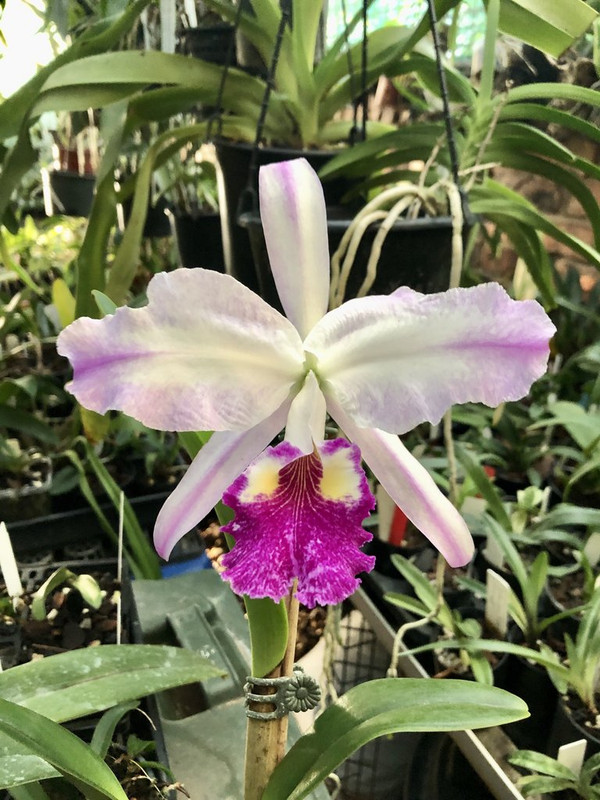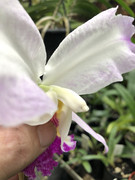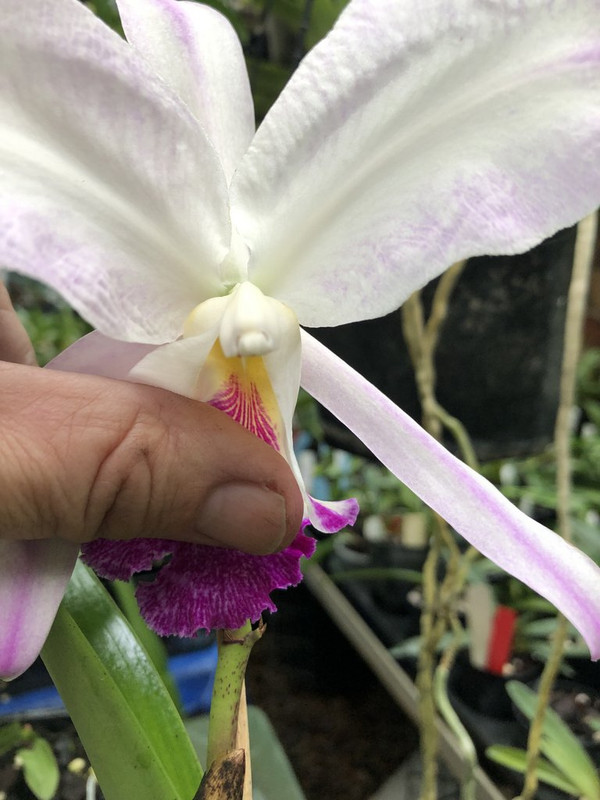You are using an out of date browser. It may not display this or other websites correctly.
You should upgrade or use an alternative browser.
You should upgrade or use an alternative browser.
C. lueddemanniana
- Thread starter Ozpaph
- Start date

Help Support Slippertalk Orchid Forum:
This site may earn a commission from merchant affiliate
links, including eBay, Amazon, and others.
That looks a lot like the famous (or infamous) clone ‘Cerro verde’ which is now accepted to be a cross between lueddemanniana and warscewiczii.
It has no varietal attached. I could try to find out if the original grower knows.
Why is it thought to be a hybrid?
Why is it thought to be a hybrid?
grower says "semi-alba" var 'Stanley', if that helps........
It could be, that’s a well known lueddemanniana semi alba clone with flares.
cerro verde flowers very very late for the species and has a ‘wrong’ column. The horns on the end of the column which are diagnostic for lueddemanniana are too small for the true species.
cerro verde flowers very very late for the species and has a ‘wrong’ column. The horns on the end of the column which are diagnostic for lueddemanniana are too small for the true species.
Those eyes on the lip definitely remind me of warscewiczii. The only other ones I can find online with those eyes are the Stanleyi flammeas or ones that are being questioned as a hybrid.It has no varietal attached. I could try to find out if the original grower knows.
Why is it thought to be a hybrid?
Stanleyi is pure semialba with no flares.
This one is ‘Cerro Verde’ clone, a very well known lueddemaniana semialba flamea with an infamous history. It came out of a jungle lueddemaniana pod that grew in Armando Mantellini’s nursery. It is a suspected hybrid with warscewiczii or sometimes mossiae due to the missing horns.
Despite that, Armando is insistent it is pure lueddemaniana and has bred with it.
To me, regardless of the controversy, I consider it one of the most beautiful flower of the flamea type.
This one is ‘Cerro Verde’ clone, a very well known lueddemaniana semialba flamea with an infamous history. It came out of a jungle lueddemaniana pod that grew in Armando Mantellini’s nursery. It is a suspected hybrid with warscewiczii or sometimes mossiae due to the missing horns.
Despite that, Armando is insistent it is pure lueddemaniana and has bred with it.
To me, regardless of the controversy, I consider it one of the most beautiful flower of the flamea type.
all the comments helpful and much appreciated.
Leslie, when you are judging a C. lueddemanniana, do you look for, and insist on, little wings on the column to consider it a true species? This would make sense to me.
Yes we do look for it to confirm ID. The horns vary in size but must be there.Leslie, when you are judging a C. lueddemanniana, do you look for, and insist on, little wings on the column to consider it a true species? This would make sense to me.
I know what the picture looks like in Chadwick’s book and think I have seen them on at least one of my lueddemannias. Here is a link to a picture made by a Cattleya grower that I think is very reputable. I don’t think your picture shows the prominent structure at the end of the column but Leslie will know for sure.
Carmella.carey
Well-Known Member
- Joined
- Mar 6, 2022
- Messages
- 545
- Reaction score
- 363
Thank you so much for the detailed pictures and description, Leslie.
My pleasure. I will always try to help if I can or know enough about a topic lol. If not, I will consult experts on them and get back to the inquiry.Thank you so much for the detailed pictures and description, Leslie.
- Joined
- Nov 14, 2022
- Messages
- 1,288
- Reaction score
- 977
I respectfully disagree I think. As judges, we are not really taxonomists in a sense.
As a team if I am presented with a plant that I suspect is, or is not, Cattleya lueddemanniana, we discus it amongst the team. If no one on the team is a Cattleya species person capable of assuring us that it is a lueddemanniana we can ‘pass’ on the plant. We can also say politely that we may have liked the plant but we suspect that the ID is wrong. Could they please get in contact with the proper Taxonomist and get it ID’d. Then in the future that particular plant has a proper ID that can follow the plant around. Or we can pass it to another team at judging that day.
We as judges generally as a rule, 99.9% of the time have to judge what we see at that moment. We can’t imagine what the plant looked like two days ago. Or what it might look like tomorrow or next week.
But this is exactly what the 6-10 year training period is for!!!
The overall shape of the flower, the size, the patterning to the lip tells me it is, or is not, a lueddemanniana. The “horns” do not enter into my consideration when it comes to scoring that plant. Not one bit.
The Cattleya score sheet provides 5 points for the lip. If the lip is perfect, full, beautifully colored, in proportion to the rest of the flower I might score it in my head as 4.5 points. Out of 5 total points, what could I possibly deduct for short horns? .2 of a point. Now we start to get too far off track.
Now if we score something labeled as lueddemanniana but a single judge on the team is not convinced, we can have the award declared provisional. It is held in ‘limbo’ for at least a year until it is properly identified. If it is, then the award goes forward. The Judging Center Chair has the power to do that.
We judge Cattleyas based on 100 points. So many for Form, Size, Color, floriferousness etc. but there is no place on the form to score for horns. That hopefully, I have shown is a taxonomic issue, not a flower quality award issue.
As a team if I am presented with a plant that I suspect is, or is not, Cattleya lueddemanniana, we discus it amongst the team. If no one on the team is a Cattleya species person capable of assuring us that it is a lueddemanniana we can ‘pass’ on the plant. We can also say politely that we may have liked the plant but we suspect that the ID is wrong. Could they please get in contact with the proper Taxonomist and get it ID’d. Then in the future that particular plant has a proper ID that can follow the plant around. Or we can pass it to another team at judging that day.
We as judges generally as a rule, 99.9% of the time have to judge what we see at that moment. We can’t imagine what the plant looked like two days ago. Or what it might look like tomorrow or next week.
But this is exactly what the 6-10 year training period is for!!!
The overall shape of the flower, the size, the patterning to the lip tells me it is, or is not, a lueddemanniana. The “horns” do not enter into my consideration when it comes to scoring that plant. Not one bit.
The Cattleya score sheet provides 5 points for the lip. If the lip is perfect, full, beautifully colored, in proportion to the rest of the flower I might score it in my head as 4.5 points. Out of 5 total points, what could I possibly deduct for short horns? .2 of a point. Now we start to get too far off track.
Now if we score something labeled as lueddemanniana but a single judge on the team is not convinced, we can have the award declared provisional. It is held in ‘limbo’ for at least a year until it is properly identified. If it is, then the award goes forward. The Judging Center Chair has the power to do that.
We judge Cattleyas based on 100 points. So many for Form, Size, Color, floriferousness etc. but there is no place on the form to score for horns. That hopefully, I have shown is a taxonomic issue, not a flower quality award issue.
Last edited:
You might have misunderstood me. I never said that the horns were scored for points. I merely state that the presence of the horns can help in the ID of this one species as it is a well known trait of lueddemanianas.I respectfully disagree I think. As judges, we are not really taxonomists in a sense.
As a team if I am presented with a plant that I suspect is, or is not, Cattleya lueddemanniana, we discus it amongst the team. If no one on the team is a Cattleya species person capable of assuring us that it is a lueddemanniana we can ‘pass’ on the plant. We can also say politely that we may have liked the plant but we suspect that the ID is wrong. Could they please get in contact with the proper Taxonomist and get it ID’d. Then in the future that particular plant has a proper ID that can follow the plant around. Or we can pass it to another team at judging that day.
We as judges generally as a rule, 99.9% of the time have to judge what we see at that moment. We can’t imagine what the plant looked like two days ago. Or what it might look like tomorrow or next week.
But this is exactly what the 6-10 year training period is for!!!
The overall shape of the flower, the size, the patterning to the lip tells me it is, or is not, a lueddemanniana. The “horns” do not enter into my consideration when it comes to scoring that plant. Not one bit.
The Cattleya score sheet provides 5 points for the lip. If the lip is perfect, full, beautifully colored, in proportion to the rest of the flower I might score it in my head as 4.5 points. Out of 5 total points, what could I possibly deduct for short horns? .2 of a point. Now we start to get too far off track.
Now if we score something labeled as lueddemanniana but a single judge on the team is not convinced, we can have the award declared provisional. It is held in ‘limbo’ for at least a year until it is properly identified. If it is, then the award goes forward. The Judging Center Chair has the power to do that.
We judge Cattleyas based on 100 points. So many for Form, Size, Color, floriferousness etc. but there is no place on the form to score for horns. That hopefully, I have shown is a taxonomic issue, not a flower quality award issue.
I agree, if in doubt (when awarded), send to SITF.
- Joined
- Nov 14, 2022
- Messages
- 1,288
- Reaction score
- 977
No, I understood that. So sorry if you felt that way. I sincerely apologize if it caused any upset or confusion.
The question posed by terryros was whether or not the wings were looked for when it comes to determining whether or not we are judging a true lueddemanniana at the judging table or not. And it is that idea or notion to which I was replying to. You did reply that you do look for those.
That question regarding a plants identification is some thing we do not typically delve into as judges. At least not in my 27 years as a judge. A large portion of my response was about what can happen in judging if we suspect that the plant entered is not what is on the entry form.
Quite a few misconceptions are floating around with what actually happens at a judging, and those are certainly understandable. It is those misconceptions that make me encourage people of local societies to attend monthly judges. They are always welcome. This is not some secret proceeding that we attend.
The question posed by terryros was whether or not the wings were looked for when it comes to determining whether or not we are judging a true lueddemanniana at the judging table or not. And it is that idea or notion to which I was replying to. You did reply that you do look for those.
That question regarding a plants identification is some thing we do not typically delve into as judges. At least not in my 27 years as a judge. A large portion of my response was about what can happen in judging if we suspect that the plant entered is not what is on the entry form.
Quite a few misconceptions are floating around with what actually happens at a judging, and those are certainly understandable. It is those misconceptions that make me encourage people of local societies to attend monthly judges. They are always welcome. This is not some secret proceeding that we attend.
Noted and thank you for clarification.
Similar threads
- Replies
- 1
- Views
- 144
- Replies
- 1
- Views
- 552








